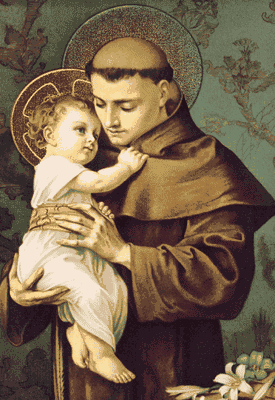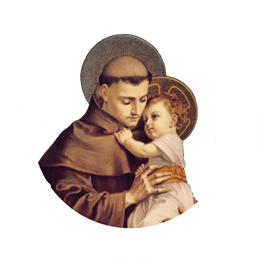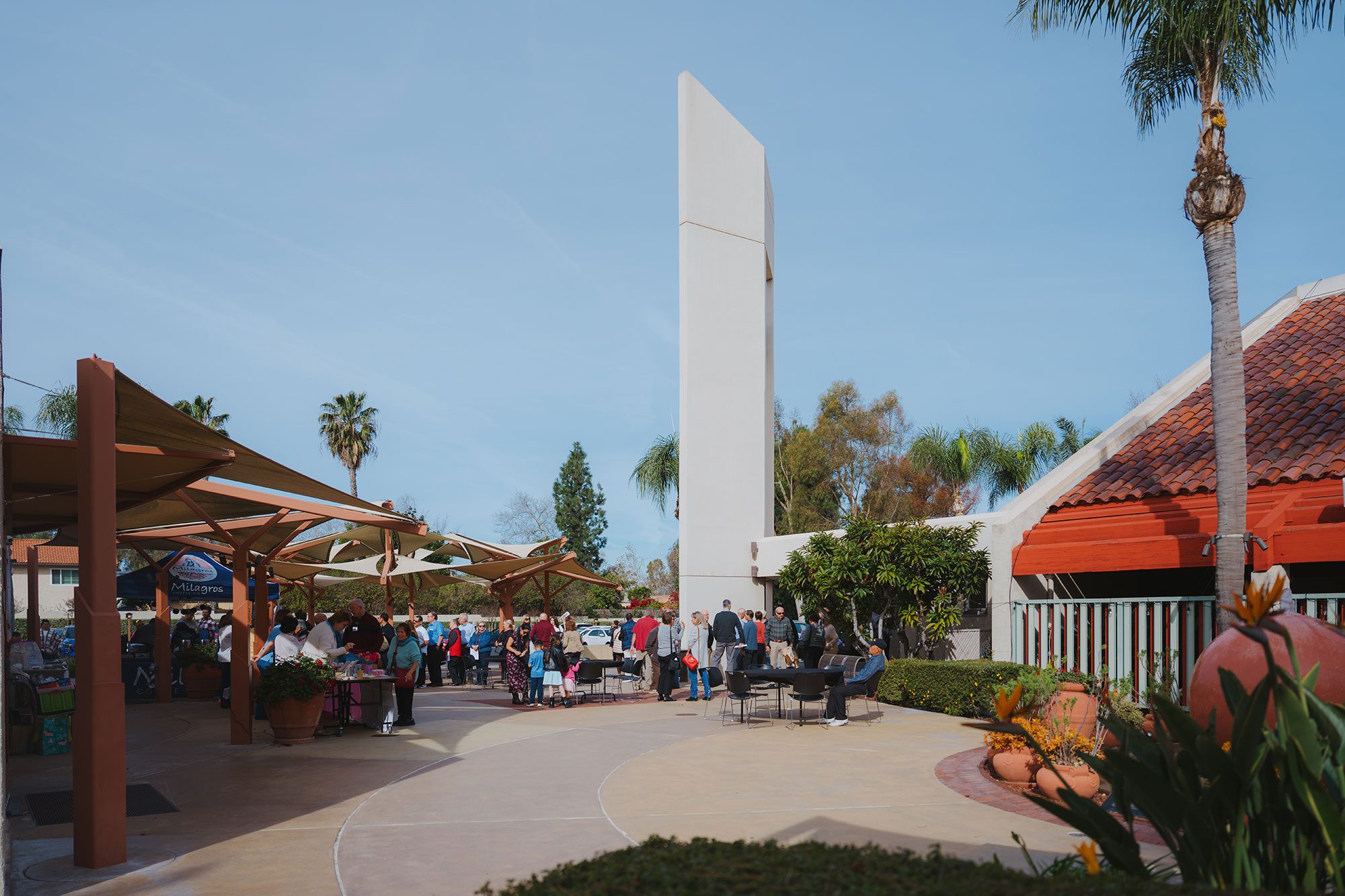To Love and Serve the Lord
We the people of San Antonio parish strive to be a community of faith, hope, and love. We find our identity and
mission in Jesus Christ and His Gospel. We celebrate our life as Catholic Christians in word, worship, and service. By
recognizing our baptism, we accept our call to personal renewal and reach out with the gospel message to families
and individuals, extending an invitation to fellowship with us.
Our Patron Saint
San Antonio de Padua (Saint Anthony of Padua)
DOCTOR OF THE CHURCH FEAST DAY: JUNE 13 ~ b.1195 d.1231 ~ Canonized (declared a saint) less than one year after his death.

Prayer to Saint Anthony

 O Holy St. Anthony, gentlest of Saints, your love for God and Charity for His creatures, made you worthy, when on earth, to possess miraculous powers. Encouraged by this thought, I implore you to obtain for me [your request here]. 0 gentle and loving St. Anthony, whose heart was ever full of human sympathy, whisper my petition into the ears of the sweet Infant Jesus, who loved to be folded in your arms; and the gratitude of my heart will ever be yours. Amen.
O Holy St. Anthony, gentlest of Saints, your love for God and Charity for His creatures, made you worthy, when on earth, to possess miraculous powers. Encouraged by this thought, I implore you to obtain for me [your request here]. 0 gentle and loving St. Anthony, whose heart was ever full of human sympathy, whisper my petition into the ears of the sweet Infant Jesus, who loved to be folded in your arms; and the gratitude of my heart will ever be yours. Amen.
FRANCISCAN ORDER
There is perhaps no more loved and admired saint in the Catholic Church than Saint Anthony of Padua, a Doctor of the Church. Though his work was in Italy, he was born in Portugal. He first joined the Augustinian Order and then left it and joined the Franciscan Order in 1221, when he was 26 years old. The reason he became a Franciscan was because of the death of the five Franciscan protomartyrs — St. Bernard, St. Peter, St. Otho, St. Accursius, and St. Adjutus — who shed their blood for the Catholic Faith in the year 1220, in Morocco, in North Africa, and whose headless and mutilated bodies had been brought to St. Anthony’s monastery on their way back for burial. St. Anthony became a Franciscan in the hope of shedding his own blood and becoming a martyr. He lived only ten years after joining the Franciscan Order.
HAMMER OF THE HERETICS
 So simple and resounding was his teaching of the Catholic Faith, so that the most unlettered and innocent might understand it, that he was made a Doctor of the Church by Pope Pius XII in 1946. Saint Anthony was only 36 years old when he died. He is called the “hammer of the Heretics” His great protection against their lies and deceits in the matter of Christian doctrine was to utter, simply and innocently, the Holy Name of Mary. When St. Anthony of Padua found he was preaching the true Gospel of the Catholic Church to heretics who would not listen to him, he then went out and preached it to the fishes. This was not, as liberals and naturalists are trying to say, for the instruction of the fishes, but rather for the glory of God, the delight of the angels, and the easing of his own heart. St. Anthony wanted to profess the Catholic Faith with his mind and his heart, at every moment.
So simple and resounding was his teaching of the Catholic Faith, so that the most unlettered and innocent might understand it, that he was made a Doctor of the Church by Pope Pius XII in 1946. Saint Anthony was only 36 years old when he died. He is called the “hammer of the Heretics” His great protection against their lies and deceits in the matter of Christian doctrine was to utter, simply and innocently, the Holy Name of Mary. When St. Anthony of Padua found he was preaching the true Gospel of the Catholic Church to heretics who would not listen to him, he then went out and preached it to the fishes. This was not, as liberals and naturalists are trying to say, for the instruction of the fishes, but rather for the glory of God, the delight of the angels, and the easing of his own heart. St. Anthony wanted to profess the Catholic Faith with his mind and his heart, at every moment.
FINDER OF LOST ARTICLES
He is typically depicted with a book and the Infant Child Jesus, to whom He miraculously appeared, and is commonly referred to today as the “finder of lost articles.” Upon exhumation, some 336 years after his death, his body was found to be corrupted, yet his tongue was totally incorrupt, so perfect were the teachings that had been formed upon it.
Our History
ESTABLISHED:
October 1, 1977
The history of San Antonio Parish can actually be traced to 1769 when Jose Antonio Yorba, a young Spanish soldier of the Portola expedition, first saw what is now Orange County. Yorba later returned as one of the several large landowners who established Ranchos in the area.
On August 1, 1834, one of Jose’s sons, Bernardo, moved across the Santa Ana River from what is now Anaheim Hills, to establish Rancho Cañon de Santa Ana. He built a large hacienda complete with a chapel dedicated to St. Anthony of Padua. Before his death in 1860, Don Bernardo began the construction on a public chapel made of adobe.
On April 19, 1860, the chapel was dedicated with a Mass for the soul of Don Bernardo and named the Chapel, San Antonio de Padua de Santa Ana.
1880 — WOODEN CHAPEL
Originally priests came from the mission San Gabriel to say Mass, but in 1875, after the founding of the St Boniface parish in Anaheim, the little chapel became a mission of that parish. In 1880 a wooden chapel replaced the deteriorating adobe structure and that chapel stood until 1956 when it was torn down.
1977 — OFFICIALLY NAMED
The chapel’s name would once again come to grace the part of the Santa Ana Canyon know as Anaheim Hills, when Bishop William Johnson created a new parish on June 8, 1977. He appointed the Rev. Seamus A. Glynn as the founding pastor and gave permission for Father Seamus to seek the recommendations of parishioners as to a name for the new parish. On September 1, 1977 the name San Antonio was suggested and forwarded to the bishop. He approved it as San Antonio de Padua del Cañon.
1977 — OFFICIALLY CREATED
The parish was officially created on September 23, 1977 and the first Mass was held on Saturday, October 1, in the cafeteria of El Rancho Middle School. The parish began with 853 registered families. On February 8, 1981 the first mass held in the new church with over 1100 in attendance. The final piece of the church was added on September 18, 1982, when the bells were installed. By its tenth anniversary in 1987, the parish had grown to 1909 families.
1999 — ST. FRANCIS OF ASSISI CATHOLIC SCHOOL
In May of 1995 the pastoral council conducted a needs assessment survey and out of this came a recommendation for the building of a Catholic elementary school. In partnership with St. Martin de Porres Parish of Yorba Linda, a $3 million campaign was launched to build a school on land northeast Yorba Linda donated by the Diocese of Orange. In 1996 Bishop McFarland approved the school project and St. Francis of Assisi Catholic Elementary School opened for classes in September, 1999.
THIRD DECADE — GROWTH
In our third decade, San Antonio Parish has shown tremendous growth. We have grown to over 4,000 families. Because of all our ministries, dedicated employees, countless organizations, and supportive parishioners we have confident expectations of continued spiritual and physical growth.
History of the Stained Glass Window
Many people ask what is the significance or the meaning of the stained glass window above the altar and why is it so modern and stylized?
First, it is important to realize that after Vatican II, the church recommended that windows above the altar should never be so mesmerizing that they draw more attention to the window during Mass than to what is taking place on the altar. Therefore the designer of our window at San Antonio chose to do a stylized depiction of Jesus’ ascension into heaven.
The following is the explanation that was given to our very first parishioners.
Notice that the window is divided into nine sections. If you look closely at the top right section, you can see 5 pieces of white glass that are shaped like the upward extended hand of Jesus.
Next, notice the inverted U-shape design between the upper left and upper middle piece. This is meant to be the head of Jesus as he ascends.
All the swirling different colored glass pieces (done in colors to co-ordinate with the décor of the rest of the church) are meant to be the clouds that began to cover the figure of Jesus as He ascended into heaven.


